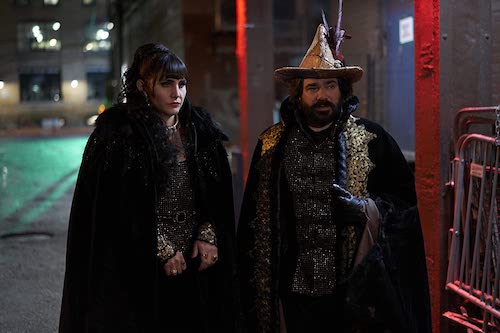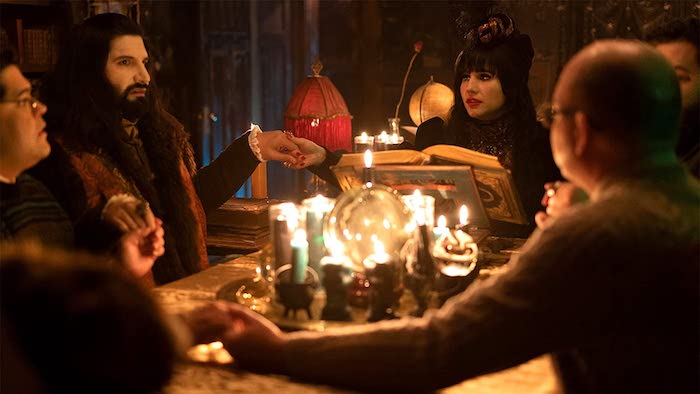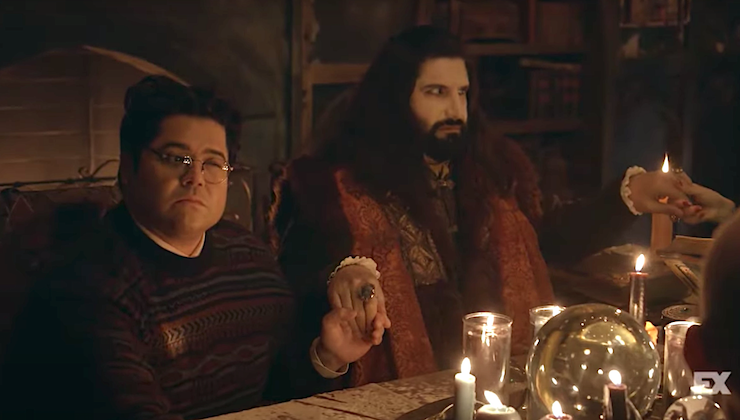sample heading
For the uninitiated, What We Do In the Shadows is the second TV spin-off of Taika Waititi and Jemaine Clement’s nigh-perfect 2014 horror-comedy/documentary parody of the same name, which explored the lives and adventures of four vampire roommates in Wellington, New Zealand. The first TV adaptation, Wellington Paranormal, came out in New Zealand in 2016 and to my knowledge hasn’t been released in the U.S. yet. The current TV iteration of WWDITS is a more direct sequel to the movie, and airs on Wednesdays at 10pm on FX. It follows four new vampires and one hapless familiar as they attempt to deal with modern Staten Island, and it’s probably the funniest thing on television right now. Since we’re already on Season Two, there will be light spoilers below!
First, the central cast: Kavyan Novak is Nandor the Relentless, a professional conqueror who pillaged his way across Europe. International Treasure Matt Berry is Laszlo Cravensworth, a British nobleman who takes the lascivious vampire stereotype to rather gross extremes. Natasia Demetriou is Nadja, a gothy Romani Vampire who is married to Lazlo, Mark Proksch is Colin Robinson the Energy Vampire, my favorite character in any media right now, and Harvey Guillén is Nandor’s long-suffering familiar Guillermo, who was inspired to pursue vampiric ways by Antonio Banderas’ performance as Armand in Interview with a Vampire. Guillermo is perfect. Guillermo is also getting frustrated that he’s worked for Nandor for ten years and still hasn’t been turned, and this frustration has been slightly complicated by Guillermo’s 23andMe-based discovery that he’s one of the last living descendants of Abraham Van Helsing.

I got to see the pilot of What We Do in the Shadows at New York Comic-Con, and it was easily one of the best con experiences I’ve ever had. The room was packed with fans of Flight of the Conchords, the original film, and Waititi’s whole deal, and I don’t think I’ve ever been in an audience that responded with such joy. I was a little nervous that the rest of the season, watched in the comparative quiet of my apartment, couldn’t sustain that energy, but instead the entire season was simply perfect, a fang-sharp mix of several different types of comedy: the development of Colin’s Energy Vampire, the introduction of Emotional Vampire Evie (played by SNL’s Vanessa Bayer), the magic of guest star Beanie Feldstein, and so on. And threaded through all of the silliness, Guillermo’s narrative, which becomes the show’s genuinely affecting emotional core.
I am so happy to say that in the first four episodes of season two, the show has already surpassed its excellent first season. (Except for the Vampire Council in “The Trial.” Nothing will ever surpass the Vampire Council.) Nandor’s cluelessness and fragility has bubbled up to the surface again and again, most often impacting poor Guillermo, while Lazlo’s cluelessness and libido have so far resulted in a dreadfully botched Super Bowl (“Superb Owl”) party, a fight with a ghost, and a ceiling festooned with ejaculate. Nadja has waxed nostalgic for the Old Country and unleashed even more of her inner Goth Girl. Guillermo’s role as Chekov’s Van Helsing Scion has come into play as he defends his housemates from other vampires, and accidentally joins a vampire hunting collective, but still insists that his vampires are cool, and that his path as a Familiar is the correct one. But again, it’s Colin Robinson who takes this show from being a fun, campy horror pastiche into an entirely different type of show. Without spoiling anything, the episode “Colin’s Promotion” has more to say about modern work culture and the horrors of middle management than all nine seasons of The Office. It gives us a full half hour of Colin Robinson, completely resets the show’s status quo, and muses on power dynamics—and I don’t think I have cry-laughed harder at anything this year.
This leads into one of the show’s strongest elements: instead of settling for simply being a very sharp horror comedy, WWDITS is both adding itself to the existing vampire canon (as in “The Trial”) and actively building on vampire lore. Colin Robinson and Evie are new types of vampires, an evolution that could only exist in our modern society, and their existence implies that there are many other subspecies of ghouls out there. With Topher we get a modern Familiar, not an addled Renfield or a true believer like Guillermo, but a millennial who uses a gig as a Familiar as one of many income streams. The episode “Brain Scramblies” takes the idea of vampires hypnotizing their victims to its furthest extreme, where instead of a possessed victim we get a man whose mind has become oatmeal from being blasted by too much psychic energy.

But the most fun to me is that the show has actually started poking at vampire mythos as a whole. In “Resurrection,” Topher the Familiar (who I must mention is played by Haley Joel Osment, who is amazing) treats the gig more like an internship than a mystical life path. But when he gets killed, Nadja takes him to a necromancer friend of hers (Benedict Wong, also amazing) to try to revivify him. Rather than fully returning to life, he becomes a zombie, eating live birds, and attacking Guillermo. Despite this, Zombie-Topher still remembers certain aspects of Living-Topher, for instance his love of aggressive high-fives—though now his arms pop off when he attempts them. In the next episode, “Ghosts,” the household discovers they’re being haunted. At first Lazlo, Nandor, and Colin Robinson scoff at the idea of ghosts (“This is where we draw the line?” Guillermo reasonably asks), but once they come around, the vampires start asking a question that’s never occurred to them: if they’re undead, soulless creatures, does that mean that they also all have ghosts out there somewhere? Seances ensue, and we get a really fun interrogation of how exactly this magical universe works, where a person can be a vampire, with all of their living memories, while simultaneously existing alongside the ghost of the human they used to be, who also has all that person’s living memories PLUS a nagging sense of unfinished business to complete before they can move on to an afterlife, and whose cosmic progress seems unaffected by the actions of the vampires who were once… them?
The thing I love the most in any media is nimbleness. I love it when a show can turn on a line reading, or a short story can shift genres within a paragraph. That nimbleness is part of what makes What We Do In The Shadows such a rich experience. The writers can shift between slapstick, horror parody, workplace satire, documentary parody, splattercore, toilet humor, and even real emotional depth in a single scene. During one seance in “Ghosts,” the show exploits the clash between Colin Robinson’s full Dilbert persona, Nadja’s over-the-top spooookiness, Lazlo and Nandor teasing Nadja with potty humor, and Guillermo rolling his eyes at the documentary cameras, Jim Halpert-style. And by the end of the episode, the show has also taken a masturbation gag to its natural conclusion and created a surprising twist on the “creepy possessed doll” subgenre. The writers throw so many different types of comedy into the mix that it should be chaos—instead, they’re so dedicated to taking their central premise seriously that each joke layers together to make a perfect comedy lasagna. And as if that wasn’t enough: the possessed doll is genuinely creepy. Two episodes later, “The Curse” veers away from its comedic tone to give us a visceral vampire attack that doesn’t play as joke either to its victims or to the audience. These characters who could be one-note jokes are real, three-dimensional characters with lives and pasts, which is why it works so well when the show chooses to give weight to the horror aspect of horror-comedy.
What We Do in the Shadows isn’t just riffing on horror tropes or mockumentary clichés, and it isn’t coasting on the fun of its source material. Instead, it’s using the half-hour sitcom to take the subgenre of horror-comedy in new directions—and it’s doing it while being the funniest thing on television.



